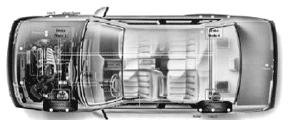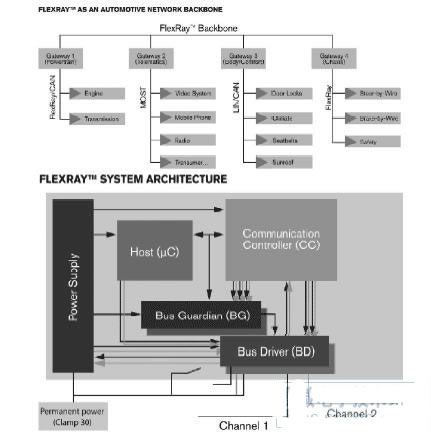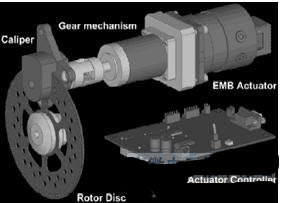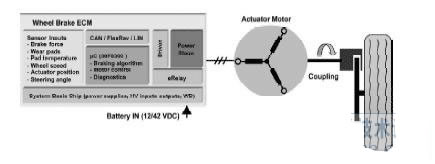Do you often need to add brake fluid to the brakes of the car? You need to pump out the brake fluid to ensure that there is no gas in the brake fluid. Although this work may not be done by the owner, this fact proves that even more modern In the electro-hydraulic brake system, we still have to suffer from the so-called "wet" system. With the advent of "wire-by-wire" technology, we will be able to use lightweight, efficient and simpler electromechanical systems, such as Brake-By-Wire, to replace bulky hydraulic systems and dirty toxic liquids. And completely get rid of them.
This article refers to the address: http://

However, the process of developing the wire-controlled technology is not smooth. Existing network protocols are not designed for advanced automotive control systems such as wire-controlled brake technology, wire-controlled driving technology, etc. Such applications require high-bandwidth, fault-tolerant deterministic communication protocols that are not currently in place in the automotive market. In 2000, BMW, DaimlerChrysler, Philips and Motorola's semiconductor division (renamed Freescale Semiconductor in 2004) jointly established the FlexRayTM Alliance to achieve the following goals: developing advanced communication technologies for in-vehicle high-speed control applications. Improve vehicle safety, reliability and comfort, and provide technology that is available to all customers in the market.
The Alliance's existing 125 members are dedicated to promoting the worldwide adoption of FlexRay communication systems, making it the standard protocol for advanced powertrain, chassis and wire control systems. Designed for in-vehicle networking, FlexRay does not replace existing networks, but can be used with existing systems such as Controller Area Network (CAN), Local Interconnect Network (LIN), Media System Transmission (MOST) and J1850. .
Meet technical requirements
FlexRay provides a total data rate of 10 Mbps in each channel to meet the bandwidth requirements of future applications. Since the channel operates alone, the total data rate can reach 20Mbps, which is 20 times the current CAN standard rate (1Mbps).
FlexRay is a time-triggered architecture, which means that control signals are transmitted according to a predefined time schedule. "Deterministic" means that no unplanned events will occur regardless of what happens outside the system. In deterministic algorithms, the correct output is always predefined, and these results are based on specific inputs. In addition, the output can control subsequent operations, the result will determine the next step, and so on. The deterministic network is completely predictable regardless of the external impact. This is important for applications that require sustained high-speed performance, such as wire-controlled brakes and remote-controlled driving. The FlexRay protocol ensures minimal information latency and jitter, as well as high bandwidth (10Mbps), which reduces the number of network collisions.
Fault tolerance means that the system will continue to operate as designed, even if different parts of the system fail. More importantly, if the network performance is reduced, the severity of the failure will increase proportionally. In other words, a glitch does not cause a loss of system functionality. FlexRay supports multiple levels of fault tolerance, including scalable system fault tolerance through single-channel or dual-channel modes that provide the redundancy needed for transmission. A separate physical layer bus monitor also helps minimize system errors.
To provide a time-triggered real-time system for all FlexRay nodes, accurate global time synchronization between different nodes is required. FlexRay supports clock correction management through deviation correction and rate correction algorithms. In each cycle, "synchronization information" is transferred from the synchronization node on the network to the bus. To support a fault tolerant system, it provides at least 4 synchronization nodes. Each node receives a synchronization message and compares its clock to the clock of the synchronization node and then corrects its clock to match the clock of the synchronization node. This is a fail-safe system that does not interfere with the synchronization of other nodes if one node fails.
FlexRay networks that support high throughput, deterministic, and fault-tolerant features offer significant benefits for advanced electronically controlled security applications. Combining these three attributes, FlexRay is an ideal replacement for other car intranets and supports the FlexRay Alliance's future offerings. For example, MOST supports high data rates, but is a network standard designed to connect to in-car multimedia components and may not be suitable for powertrain, chassis, and wire-controlled applications.
CAN is an internationally standardized serial bus system that is widely used by European manufacturers for engine management, body electronics and entertainment control. At normal data rates (500 Kbps), CAN networks can connect to multiple electronic control units. In the US, it will replace the J1850 standard for diagnostics and data sharing. However, when transmitting information, CAN uses priority arbitration, which means that low-priority information is always behind high-priority information, causing delays. Only the highest priority information can be guaranteed to be transmitted at a predefined transmission time. In addition, the CAN rate is relatively low and does not have fault tolerance, so it cannot be used in advanced applications such as wire control. LIN is a sub-network with lower cost and relatively slow rate in CAN, but it cannot handle the data rate required by applications such as wire control.
FlexRay solution
FlexRay is an extensible system with static and dynamic slots that programmers can configure based on application needs. With synchronous data transmission, time-triggered communication is available for applications with high reliability requirements. Asynchronous transfers based on the byteflightTM protocol enable all FlexRay nodes to use full bandwidth for event-driven communication. Byteflight is a 10Mbps time control protocol designed to provide automotive safety related applications. With fault-tolerant synchronization and redundant transmission channels, FlexRay extends the security-oriented features of the Byteflight system protocol.
FlexRay supports both the optical and electrical physical layers, enabling manufacturers to deploy the routing mechanisms that best meet their needs. In addition, developers can extend the FlexRay system from a single-channel bus to multiple dual-channel star topologies with full channel redundancy. If FlexRay is used as the backbone of the in-vehicle network, connecting powertrains, chassis, body, security and multimedia applications (with or without FlexRay), manufacturers can even take advantage of high bandwidth.

Depending on the deterministic and fault-tolerant requirements of the application, within each node, the FlexRay module includes all the components required to implement the FlexRay protocol.
Register Module -- Contains control registers for configuring FlexRay devices and status registers for reading current protocol status information.
Information Buffer Interface - This interface is used in the CPU to receive and transmit data, including data generated by register blocks.
Protocol State Machine - The core of the communications controller. It performs the entire protocol logic, such as information processing, establishing communication cycles, startup, and error handling.
Timing unit - responsible for timing control, including support for synchronization of distributed clocks.
Cyclic Redundancy Check (CRC) Unit - Generates and verifies the checksum of each data frame during information transmission and reception.
Accept and transfer units: one per channel.
One of the public goals of the FlexRay Alliance is "to develop advanced communication technologies for in-vehicle high-speed control applications to improve safety, reliability and comfort." [Source: ]. However, as we all know, the industry is highly concerned about the wire control system, making it the main benefit of FlexRay technology. The goal is to reduce the reliance of vehicle control on the hydraulic system, the most likely application being a line brake.
FlexRay works: wire brake
Advanced Chassis Control is the best example of FlexRay's push for new technologies in new car designs. Today, a large number of vehicles use the anti-lock braking system (ABS) as a standard, but vehicle stability control is still a complex and costly problem. With the advent of the wire-controlled brake technology controlled by FlexRay, the main components of vehicle stability control will be developed in a lighter, faster, simpler and more efficient manner, which will be more widely used in advanced vehicle stability control.
Wire brake technology (also known as electromechanical brakes - EMB) eliminates the problems of brake fluid and hydraulic lines. A separate high performance motor produces braking force on each wheel, which is controlled by the central ECU and executed by signals from the electric brake pedal module. FlexRay provides a communication protocol that supports high-speed information transfer throughout the system. EMB does not provide a backup mechanical or hydraulic system provided by a conventional hydraulic brake system. FlexRay's fault-tolerant operation is critical to ensure the absolute reliability of the wire-controlled brake system.
The wire control system supported by FlexRay includes a vehicle control node that serves as a component of the ECU, a separate node provided for each wheel, and a brake pedal node. The system consists of a large number of sensors, motor brakes, electronic control modules (ECM) and reducer units, to which the brake wheel nodes belong. Fundamentally, when braking, electronic information is sent from the pedal node to the ECU, which then relays the information to the wheel node ECM. The main function of the ECM is to receive the brake pedal signal, process and provide the appropriate voltage vector so that the motor actuator can perform the necessary torque response.

The motor actuator converts electrical energy into mechanical energy that is transmitted to the brake pads via the reducer device, which then applies the brake pressure to the brake disc. FlexRay's high-bandwidth capabilities enable fast transfer of a wide range of extremely detailed information, making mechanical reactions very fast and accurate. Since each wheel node is a separate system of the FlexRay network, each wheel can provide different brake pressures at different time intervals, providing immediate stability control in different braking situations. The use of integrated sensing technology to load other information (such as weight distribution, passenger positioning, tire pressure deviation, road conditions, etc.) onto the line brakes, while the line control system will provide an unprecedented level of vehicle stability control.
In addition to the safety advantages of FlexRay-based wire-controlled brakes, there are a number of other operational factors worth considering. EMB is low noise, environmentally compliant (no brake fluid), and small in size, requiring simple assembly. It seamlessly interfaces with future traffic management systems and integrates easily with other features such as electric brakes.
Excellent value for money
With these realities in mind, FlexRay technology is quite attractive in production. FlexRay was initially expensive to install (requires twisted pair cabling), but the technology it supports can help manufacturers save time and money on the production line. In the online control system, the installation of brakes, controllers and wiring is simpler, more convenient and more reliable than the main cylinder, the secondary cylinder and a large number of associated piping. For manufacturers, their installation costs have dropped, and for users, their maintenance costs will be reduced. In addition, FlexRay provides a control protocol for a wide range of different applications, reducing the complexity of in-vehicle networking systems. In this way, more components can be reused and stability improved, reducing equipment expenditure and time required in the future.
Most automotive manufacturers currently support the FlexRay protocol. BMW, DaimlerChrysler, GM and Volkswagen are all core partners of the FlexRay Alliance. Most premium members are car manufacturers. The most important goal of the alliance is to "make FlexRay the de facto standard for the automotive industry."
The goal of the alliance is fast. Freescale Semiconductor and Royal Philips Electronics recently reached an agreement to share their FlexRay technology to accelerate the availability of FlexRay-enabled semiconductor products. Both parties now authorize each other to share their own FlexRay protocol engine design and jointly develop an executable protocol model. Freescale will introduce the FlexRay protocol engine in stand-alone devices, including: 16-bit microcontrollers, a family of digital signal controllers, and processors with PowerPC® cores. Philips is expected to integrate the FlexRay protocol engine into the entire automotive-based automotive microcontroller system. According to the FlexRay Alliance website, BMW and DaimlerChrysler are expected to introduce FlexRay into their car range in the next few years.

It can be said that manufacturers are always looking for more ways to make cars safer, more convenient, more comfortable and more reliable, and more profitable. FlexRay gives developers of new products the opportunity to have all of these attributes in the next generation and quickly assemble them.
The Tray Type Cable Tray has the advantages of: Light weight,Large carrying capacity,Beautiful shape,Simple structure and Easy installation
Tray type Cable Tray is widely used in areas such as oil,chemical engineering,electricity,light industry
and telecommunication.
It's suitable not only for the installation of power cable,but also for the
laying of control cable.
Cable tray has different maximum allowed carrying capacity and different stages
of deformation while covering different spans.There are several way of cable tray surface procession.
like electrostatic spray,galvanized hot dip galvanized and so on.
In high-corrosive circumstances,cable tray can take special anti-corrosive process.
And cable tray has protecters,protectors' accessories can apply to ladder type of cable
tray or Perforated cable tray.

Metal Cable Tray,Tray Shape Cable Tray,Galvanized Steel Cable Trunking,Tray Type Steel Cable Tray
Jiangsu Loncin Electric Equipment Co.,Ltd , https://www.loncincabletray.com